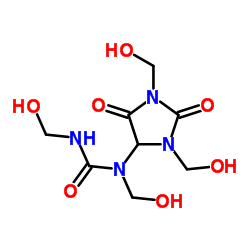Diazolidinyl urea

Diazolidinyl urea structure
|
Common Name | Diazolidinyl urea | ||
|---|---|---|---|---|
| CAS Number | 78491-02-8 | Molecular Weight | 278.219 | |
| Density | 1.8±0.1 g/cm3 | Boiling Point | 421.04°C (rough estimate) | |
| Molecular Formula | C8H14N4O7 | Melting Point | N/A | |
| MSDS | Chinese USA | Flash Point | N/A | |
| Symbol |

GHS07 |
Signal Word | Warning | |
|
Non-fragrance allergens in specific cosmetic products.
Contact Dermatitis 65(5) , 276-85, (2011) Reports about the nature of the ingredients responsible for allergic contact dermatitis caused by specific cosmetic products are scarce.Between January 2000 and December 2010, the specific cosmetic products having caused allergic contact dermatitis, as well a... |
|
|
Investigation on formaldehyde release from preservatives in cosmetics.
Int. J. Cosmet. Sci. 37 , 474-8, (2015) To understand formaldehyde residue in cosmetics, an investigation on formaldehyde release from eight preservatives (methenamine - MA, paraformaldehyde - PF, poly(p-toluenesulfonamide-co-formaldehyde) -PTSAF, quaternium-15 - QU, imidazolidinyl urea - IU, diazo... |
|
|
Hand dermatitis: a focus on allergic contact dermatitis to biocides.
Dermatol. Clin. 27(3) , 251-64, v-vi, (2009) Hand dermatitis is a common disease of the skin resulting in significantly decreased quality of life. Allergic contact dermatitis is a frequent cause of hand dermatitis. Recent studies have revealed that biocides used as preservatives are frequent allergens a... |
|
|
Cosmetic preservatives as therapeutic corneal and scleral tissue cross-linking agents.
Invest. Ophthalmol. Vis. Sci. 56(2) , 1274-82, (2015) Previously, aliphatic β-nitroalcohols (BNAs) have been studied as a means to chemically induce tissue cross-linking (TXL) of cornea and sclera. There are a number of related and possibly more potent agents, known as formaldehyde releasers (FARs), that are in ... |
|
|
Follow-up of the monitored levels of preservative sensitivity in Europe: overview of the years 2001-2008.
Contact Dermatitis 67(5) , 312-4, (2012)
|
|
|
Patch testing with formaldehyde and formaldehyde-releasers: multicentre study in Spain (2005-2009).
Contact Dermatitis 65(5) , 286-92, (2011) Formaldehyde and formaldehyde-releasers are common causes of allergic contact dermatitis.To determine the frequency of sensitization to formaldehyde and seven formaldehyde-releasers. To establish and characterize groups of patients according to the results of... |
|
|
Simultaneous measurement of diazolidinyl urea, urea, and allantoin in cosmetic samples by hydrophilic interaction chromatography.
J. Chromatogr. B. Analyt. Technol. Biomed. Life Sci. 877(10) , 1005-10, (2009) A new HPLC method for simultaneous measurement of diazolidinyl urea (DU), urea, and allantoin by hydrophilic interaction chromatography using a column packed with triazol-bonded silica particles is described. The calibration curves of DU, urea, and allantoin ... |
|
|
Determination of diazolidinyl urea in a topical cream by high-performance liquid chromatography.
J. Chromatogr. B. Biomed. Sci. Appl. 696(2) , 303-6, (1997) A high-performance liquid chromatographic method for the determination of diazolidinyl urea (DU) in a cream formulation is described. The aqueous phase of the emulsion was separated by centrifugation, removed, filtered, diluted and applied onto the HPLC syste... |
|
|
The different decomposition properties of diazolidinyl urea in cosmetics and patch test materials.
Contact Dermatitis 65(2) , 81-91, (2011) Diazolidinyl urea is a formaldehyde-releasing compound that releases formaldehyde through its decomposition. However, there have been few reports about the decomposition properties of diazolidinyl urea in cosmetics and patch test materials.The aim of this stu... |
|
|
Effects of the formaldehyde releasing preservatives dimethylol urea and diazolidinyl urea in several short-term genotoxicity tests.
Mutat. Res. 514(1-2) , 133-46, (2002) The two formaldehyde (FA)-releasers dimethylol urea (DMU) and diazolidinyl urea (DZU) are widely used as preservatives or additives. They were tested for genotoxicity in three short-term test systems, i.e. in the Salmonella typhimurium mutagenicity assay, in ... |